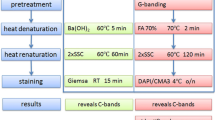Summary
G-banding patterns were found on the X-chromosomes of the housefly. This indicates the presence of major gene loci on these chromosomes, i.e. sex-linked genes. G-banding patterns were also found on the Y-chromosome of 2 preparations. The first polyploid cell (a tetraploid, 2n=24) forMusca domestica was observed in one of the banding preparations.
Similar content being viewed by others
References
N.M. Stevens, J. exp. Zool.5, 359 (1908).
R. Milani, in: The Handbook of Genetics, vol. 3. Ed. R.C. King. Plenum Press, New York and London 1976.
H.T. Imai, R.H. Crozier and R.W. Taylor, Chromosoma59, (4), 341 (1977).
M. Seabright, Lancet2, 971 (1971).
T.C. Hsu, A. Rev. Genet.7, 153 (1973).
R.H. Crozier, in: Animal Cytogenetics, vol. 3. Gebrüder Bornträger, Berlin and Stuttgart 1975.
R. Kerr, Nature185, 868 (1960).
Author information
Authors and Affiliations
Rights and permissions
About this article
Cite this article
Lester, D.S., Crozier, R.H. & Shipp, E. G-banding patterns of the housefly,Musca domestica, autosomes and sex chromosomes. Experientia 35, 174–175 (1979). https://doi.org/10.1007/BF01920595
Published:
Issue Date:
DOI: https://doi.org/10.1007/BF01920595




